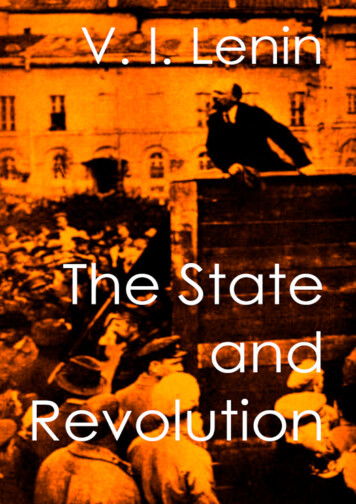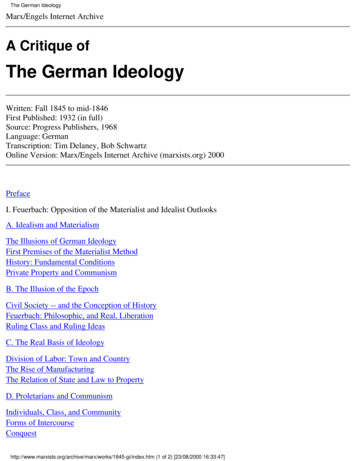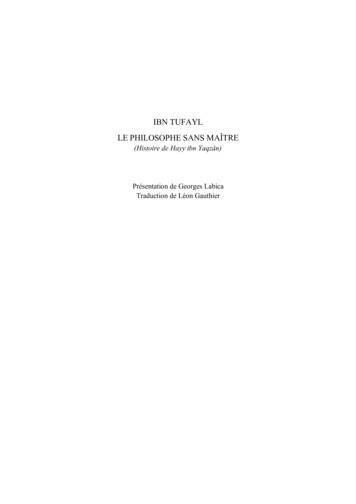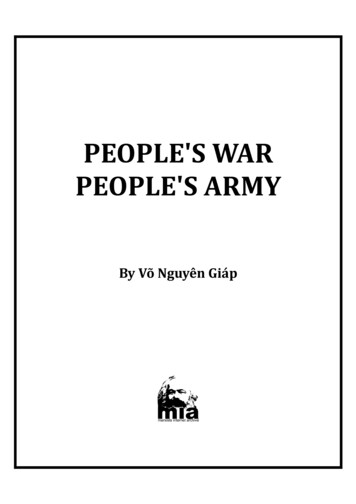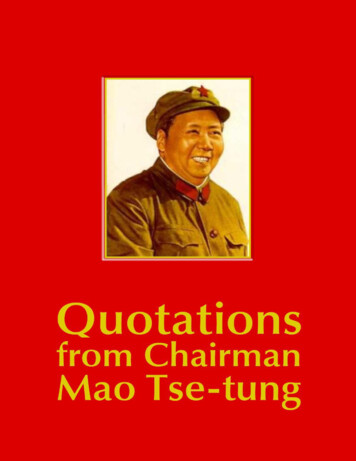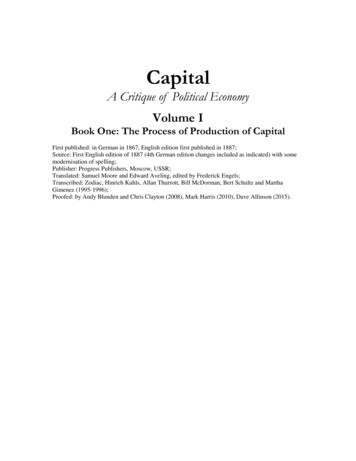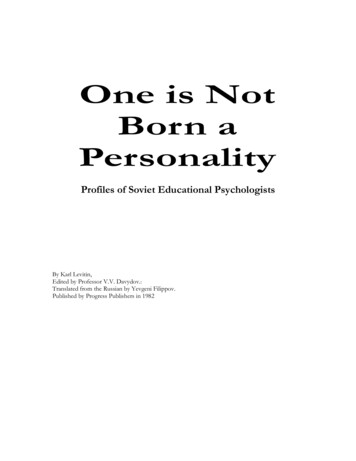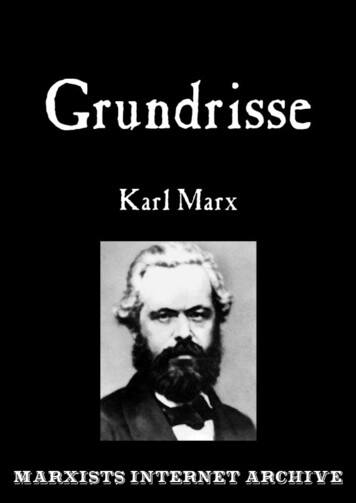
Transcription
Karl MarxGrundrisseFoundations of the Critique of Political Economy (RoughDraft)Karl MarxWritten: 1857–61;Published: in German 1939–41;Source: Grundrisse, Penguin Books in association with New Left Review, 1973;Translated by: Martin Nicolaus;Notes by: Ben Fowkes;Scanned by: Tim Delaney, 1997;HTML Mark-up: Andy Blunden, 2002; Dave Allinson, 2015;Ebook Conversion: Dave Allinson, 2015.This translation is licensed by the copyright owner, Martin Nicolaus, exclusivelyto MIA. Publication on other online sites is prohibited. Editorial notes areincluded by permission of Ben Fowkes.Available online 7/grundrisse/index.htm–2–
ContentsNote on the TextAnalytical Contents ListIntroductionThe Chapter on MoneyThe Chapter on CapitalBastiat and CareyEditorial Notes–3–
Karl MarxNote on the TextMarx wrote this huge manuscript as part of his preparation for what wouldbecome A Contribution to the Critique of Political Economy (published in1859) and Capital (published 1867).Soviet Marxologists released several never-before-seen Marx/Engels works inthe 1930s. Most were early works – like the Economic and PhilosophicalManuscripts – but the Grundrisse stood alone as issuing forth from the mostintense period of Marx’s decade-long, in-depth study of economics. It is anextremely rich and thought-provoking work, showing signs of humanism andthe influence of Hegelian dialectic method. Do note, though, Marx did notintend it for publication as is, so it can be stylistically very rough in places.The series of seven notebooks were rough-drafted by Marx, chiefly for purposesof self-clarification, during the winter of 1857-8. The manuscript became lost incircumstances still unknown and was first effectively published, in the Germanoriginal, in 1953. A limited edition was published by Foreign LanguagePublishers in Moscow in two volumes, 1939 and 1941 respectively, under theeditorship of the Marx-Engels-Lenin Institute, Moscow. The first volumecontained the introduction and the seven notebooks translated here. Thesecond added fragments from Marx’s 1851 notebooks of excerpts from Ricardo,the fragment ‘Bastiat and Carey’ (also included in this translation), andmiscellaneous related material; also extensive annotations and sources. Aphoto-offset reprint of the two volumes bound in one, minus illustrations andfacsimiles, was issued by Dietz Verlag, Berlin (E.), in 1953, and is the basis ofthe present translation. It is referred to hereafter as Grundrisse. Rosdolskystates that only three or four copies of the 1939-41 edition ever reached ‘thewestern world’.–4–
GrundrisseAnalytical Contents ListINTRODUCTION (Notebook M)(1) Production in general(2) General relation between production, distribution, exchange andconsumption(3) The method of political economy(4) Means (forces) of production and relations of production, relations ofproduction and relations of circulationTHE CHAPTER ON MONEY (Notebooks I and II, pp. 1–7)Darimon’s theory of crisesGold export and crisesConvertibility and note circulationValue and priceTransformation of the commodity into exchange value; moneyContradictions in the money relation(1) Contradiction between commodity as product and commodity as exchangevalue(2) Contradiction between purchase and sale(3) Contradiction between exchange for the sake of exchange and exchange forthe sake of commodities(Aphorisms)(4) Contradiction between money as particular commodity and money asgeneral commodity(The Economist and the Morning Star on money)Attempts to overcome the contradictions by the issue of time-chitsExchange value as mediation of private interestsExchange value (money) as social bondSocial relations which create an undeveloped system of exchangeThe product becomes a commodity; the commodity becomes exchange value;the exchange value of the commodity becomes moneyMoney as measureMoney as objectification of general labour time(Incidental remark on gold and silver)Distinction between particular labour time and general labour timeDistinction between planned distribution of labour time and measurement ofexchange values by labour time(Strabo on money among the Albanians)–5–
Karl MarxThe precious metals as subjects of the money relation(a) Gold and silver in relation to the other metals(b) Fluctuations in the value-relations between the different metals(c) and (d) (headings only): Sources of gold and silver; money as coinCirculation of money and opposite circulation of commoditiesGeneral concept of circulation(a) Circulation circulates exchange values in the form of prices(Distinction between real money and accounting money)(b) Money as the medium of exchange(What determines the quantity of money required for circulation)(Comment on (a))Commodity circulation requires appropriation through alienationCirculation as an endlessly repeated processThe price as external to and independent of the commodityCreation of general medium of exchangeExchange as a special businessDouble motion of circulation: C–M; M–C, and M–C; C–MThree contradictory functions of money(1) Money as general material of contracts, as measuring unit of exchangevalues(2) Money as medium of exchange and realizer of prices(Money, as representative of price, allows commodities to be exchanged atequivalent prices)(An example of confusion between the contradictory functions of money)(Money as particular commodity and money as general commodity)(3) Money as money: as material representative of wealth (accumulation ofmoney)(Dissolution of ancient communities through money)(Money, unlike coin, has a universal character)(Money in its third function is the negation (negative unity) of its character asmedium of circulation and measure)(Money in its metallic being; accumulation of gold and silver)(Headings on money, to be elaborated later)THE CHAPTER ON CAPITAL (Notebooks II pp. 8–28, III–VII)The Chapter on Money as CapitalDifficulty in grasping money in its fully developed character as moneySimple exchange: relations between the exchangers(Critique of socialists and harmonizers: Bastiat, Proudhon)–6–
GrundrisseSECTION ONE: THE PRODUCTION PROCESS OF CAPITALNothing is expressed when capital is characterized merely as a sum of valuesLanded property and capitalCapital comes from circulation; its content is exchange value; merchantcapital, money capital, and money interestCirculation presupposes another process; motion between presupposedextremesTransition from circulation to capitalist productionCapital is accumulated labour (etc.)‘Capital is a sum of values used for the production of values’Circulation, and exchange value deriving from circulation, the presuppositionof capitalExchange value emerging from circulation, a presupposition of circulation,preserving and multiplying itself in it by means of labourProduct and capital. Value and capital. ProudhonCapital and labour. Exchange value and use value for exchange valueMoney and its use value (labour) in this relation capital. Self-multiplication ofvalue is its only movementCapital, as regards substance, objectified labour. Its antithesis living,productive labourProductive labour and labour as performance of a serviceProductive and unproductive labour. A. Smith etc.The two different processes in the exchange of capital with labourCapital and modern landed propertyThe marketExchange between capital and labour. Piecework wagesValue of labour powerShare of the wage labourer in general wealth determined only quantitativelyMoney is the worker’s equivalent; he thus confronts capital as an equalBut the aim of his exchange is satisfaction of his need. Money for him is onlymedium of circulationSavings, self-denial as means of the worker’s enrichmentValuelessness and devaluation of the worker a condition of capital(Labour power as capital!)Wages not productiveThe exchange between capital and labour belongs within simple circulation,does not enrich the workerSeparation of labour and property the precondition of this exchange–7–
Karl MarxLabour as object absolute poverty, labour as subject general possibility ofwealthLabour without particular specificity confronts capitalLabour process absorbed into capital(Capital and capitalist)Production process as content of capitalThe worker relates to his labour as exchange value, the capitalist as use valueThe worker divests himself of labour as the wealth-producing power; capitalappropriates it as suchTransformation of labour into capitalRealization process(Costs of production)Mere self-preservation, non-multiplication of value contradicts the essence ofcapitalCapital enters the cost of production as capital. Interest-bearing capital(Parentheses on: original accumulation of capital, historic presuppositions ofcapital, production in general)Surplus value. Surplus labour timeValue of labour. How it is determinedConditions for the self-realization of capitalCapital is productive as creator of surplus labourBut this is only a historical and transitory phenomenonTheories of surplus value (Ricardo; the Physiocrats; Adam Smith; Ricardoagain)Surplus value and productive force. Relation when these increaseResult: in proportion as necessary labour is already diminished, the realizationof capital becomes more difficultConcerning increases in the value of capitalLabour does not reproduce the value of material and instrument, but ratherpreserves it by relating to them in the labour process as to their objectiveconditionsAbsolute surplus labour time. RelativeIt is not the quantity of living labour, but rather its quality as labour whichpreserves the labour time already contained in the materialThe change of form and substance in the direct production processIt is inherent in the simple production process that the previous stage ofproduction is preserved through the subsequent onePreservation of the old use value by new labour–8–
GrundrisseThe quantity of objectified labour is preserved because contact with livinglabour preserves its quality as use value for new labourIn the real production process, the separation of labour from its objectivemoments of existence is suspended. But in this process labour is alreadyincorporated in capitalThe capitalist obtains surplus labour free of charge together with themaintenance of the value of material and instrumentThrough the appropriation of present labour, capital already possesses a claimto the appropriation of future labourConfusion of profit and surplus value. Carey’s erroneous calculationThe capitalist, who does not pay the worker for the preservation of the oldvalue, then demands remuneration for giving the worker permission topreserve the old capitalSurplus Value and ProfitDifference between consumption of the instrument and of wages. The formerconsumed in the production process, the latter outside itIncrease of surplus value and decrease in rate of profitMultiplication of simultaneous working daysMachineryGrowth of the constant part of capital in relation to the variable part spent onwages growth of the productivity of labourProportion in which capital has to increase in order to employ the samenumber of workers if productivity risesPercentage of total capital can express very different relationsCapital (like property in general) rests on the productivity of labourIncrease of surplus labour time. Increase of simultaneous working days.(Population)(Population can increase in proportion as necessary labour time becomessmaller)Transition from the process of the production of capital into the process ofcirculationSECTION TWO: THE CIRCULATION PROCESS OF CAPITALDevaluation of capital itself owing to increase of productive forces(Competition)Capital as unity and contradiction of the production process and therealization processCapital as limit to production. OverproductionDemand by the workers themselvesBarriers to capitalist production–9–
Karl MarxOverproduction; ProudhonPrice of the commodity and labour timeThe capitalist does not sell too dear; but still above what the thing costs himPrice can fall below value without damage to capitalNumber and unit (measure) important in the multiplication of pricesSpecific accumulation of capital. (Transformation of surplus labour intocapital)The determination of value and of pricesThe general rate of profitThe capitalist merely sells at his own cost of production, then it is a transfer toanother capitalist. The worker gains almost nothing therebyBarrier of capitalist production. Relation of surplus labour to necessary labour.Proportion of the surplus consumed by capital to that transformed into capitalDevaluation during crisesCapital coming out of the production process becomes money again(Parenthesis on capital in general)Surplus Labour or Surplus Value Becomes Surplus CapitalAll the determinants of capitalist production now appear as the result of(wage) labour itselfThe realization process of labour at the same time its de-realization processFormation of surplus capital ISurplus capital IIInversion of the law of appropriationChief result of the production and realization processOriginal Accumulation of CapitalOnce developed historically, capital itself creates the conditions of its existence(Performance of personal services, as opposed to wage labour)(Parenthesis on inversion of the law of property, real alien relation of theworker to his product, division of labour, machinery)Forms which precede capitalist production. (Concerning the process whichprecedes the formation of the capital relation or of original accumulation)Exchange of labour for labour rests on the worker’s propertylessnessCirculation of capital and circulation of moneyProduction process and circulation process moments of production. Theproductivity of the different capitals (branches of industry) determines that ofthe individual capitalCirculation period. Velocity of circulation substitutes for volume of capital.Mutual dependence of capitals in the velocity of their circulation– 10 –
GrundrisseThe four moments in the turnover of capitalMoment II to be considered here: transformation of the product into money;duration of this operationTransport costsCirculation costsMeans of communication and transportDivision of the branches of labourConcentration of many workers; productive force of this concentrationGeneral as distinct from particular conditions of productionTransport to market (spatial condition of circulation) belongs in the productionprocessCredit, the temporal moment of circulationCapital is circulating capitalInfluence of circulation on the determination of value; circulation time timeof devaluationDifference between the capitalist mode of production and all earlier ones(universality, propagandistic nature)(Capital itself is the contradiction)Circulation and creation of valueCapital not a source of value-creationContinuity of production presupposes suspension of circulation timeTheories of Surplus ValueRamsay’s view that capital is its own source of profitNo surplus value according to Ricardo’s lawRicardo’s theory of value. Wages and profitQuinceyRicardoWakefield. Conditions of capitalist production in coloniesSurplus value and profit. Example (Malthus)Difference between labour and labour capacityCarey’s theory of the cheapening of capital for the workerCarey’s theory of the decline of the rate of profitWakefield on the contradiction between Ricardo’s theories of wage labour andof valueBailey on dormant capital and increase of production without previousincrease of capitalWade’s explanation of capital. Capital, collective force. Capital, civilizationRossi. What is capital? Is raw material capital? Are wages necessary for it?– 11 –
Karl MarxMalthus. Theory of value and of wagesAim of capitalist production value (money), not commodity, use value etc.ChalmersDifference in return. Interruption of the production process. Total duration ofthe production process. Unequal periods of productionThe concept of the free labourer contains the pauper. Population andoverpopulationNecessary labour. Surplus labour. Surplus population. Surplus capitalAdam Smith: work as sacrificeAdam Smith: the origin of profitSurplus labour. Profit. WagesImmovable capital. Return of capital. Fixed capital. John Stuart MillTurnover of capital. Circulation process. Production processCirculation costs. Circulation timeCapital’s change of form and of substance; different forms of capital;circulating capital as general character of capitalFixed (tied down) capital and circulating capitalConstant and variable capitalCompetitionSurplus value. Production time. Circulation time. Turnover timeCompetition (continued)Part of capital in production time, part in circulation timeSurplus value and production phase. Number of reproductions of capital number of turnoversChange of form and of matter in the circulation of capital C–M–C. M–C–MDifference between production time and labour timeFormation of a mercantile estate; creditSmall-scale circulation. The process of exchange between capital and labourcapacity generallyThreefold character, or mode, of circulationFixed capital and circulating capitalInfluence of fixed capital on the total turnover time of capitalFixed capital. Means of labour. MachineTransposition of powers of labour into powers of capital both in fixed and incirculating capitalTo what extent fixed capital (machine) creates valueFixed capital & continuity of the production process. Machinery & livinglabour– 12 –
GrundrisseContradiction between the foundation of bourgeois production (value asmeasure) and its developmentSignificance of the development of fixed capital (for the development of capitalgenerally)The chief role of capital is to create disposable time; contradictory form of thisin capitalDurability of fixed capitalReal saving (economy) saving of labour time development of productiveforceTrue conception of the process of social productionOwen’s historical conception of industrial (capitalist) productionCapital and value of natural agenciesScope of fixed capital indicates the level of capitalist productionIs money fixed capital or circulating capital?Turnover time of capital consisting of fixed capital and circulating capital.Reproduction time of fixed capitalThe same commodity sometimes circulating capital, sometimes fixed capitalEvery moment which is a presupposition of production is at the same time itsresult, in that it reproduces its own conditionsThe counter-value of circulating capital must be produced within the year. Notso for fixed capital. It engages the production of subsequent yearsMaintenance costs of fixed capitalRevenue of fixed capital and circulating capitalFree labour latent pauperism. EdenThe smaller the value of fixed capital in relation to its product, the more usefulMovable and immovable, fixed and circulatingConnection of circulation and reproductionSECTION THREE: CAPITAL AS FRUCTIFEROUS.TRANSFORMATION OF SURPLUS VALUE INTO PROFITRate of profit. Fall of the rate of profitSurplus value as profit always expresses a lesser proportionWakefield, Carey and Bastiat on the rate of profitCapital and revenue (profit). Production and distribution. SismondiTransformation of surplus value into profitLaws of this transformationSurplus value relation of surplus labour to necessary labourValue of fixed capital and its productive powerMachinery and surplus labour. Recapitulation of the doctrine of surplus value– 13 –
Karl MarxgenerallyRelation between the objective conditions of production. Change in theproportion of the component parts of capitalMISCELLANEOUSMoney and fixed capital: presupposes a certain amount of wealth. Relation offixed capital and circulating capital. (Economist)Slavery and wage labour; profit upon alienation (Steuart)Steuart, Montanari and Gouge on moneyThe wool industry in England since Elizabeth; silk-manufacture; iron; cottonOrigin of free wage labour. Vagabondage. (Tuckett)Blake on accumulation and rate of profit; dormant capitalDomestic agriculture at the beginning of the sixteenth century. (Tuckett)Profit. Interest. Influence of machinery on the wage fund. (WestminsterReview)Money as measure of values and yardstick of prices. Critique of theories of thestandard measure of moneyTransformation of the medium of circulation into money. Formation oftreasures. Means of payment. Prices of commodities and quantity ofcirculating money. Value of moneyCapital, not labour, determines the value of money. (Torrens)The minimum of wagesCotton machinery and working men in 1826. (Hodgskin)How the machine creates raw material. (Economist)Machinery and surplus labourCapital and profit. Relation of the worker to the conditions of labour incapitalist production. All parts of capital bring a profitTendency of the machine to prolong labourCotton factories in England. Example for machinery and surplus labourExamples from Glasgow for the rate of profitAlienation of the conditions of labour with the development of capital.InversionMerivale. Natural dependence of the worker in colonies to be replaced byartificial restrictionsHow the machine saves material. Bread. D’eau de la MalleDevelopment of money and interestProductive consumption. Newman. Transformations of capital. Economic cycleDr Price. Innate power of capitalProudhon. Capital and simple exchange. Surplus– 14 –
GrundrisseNecessity of the worker’s propertylessnessGalianiTheory of savings. StorchMacCulloch. Surplus. ProfitArnd. Natural interestInterest and profit. CareyHow merchant takes the place of masterMerchant wealthCommerce with equivalents impossible. OpdykePrincipal and interestDouble standardOn moneyJames Mill’s false theory of pricesRicardo on currencyOn moneyTheory of foreign trade. Two nations may exchange according to the law ofprofit in such a way that both gain, but one is always defraudedMoney in its third role, as money(I) VALUE (This section to be brought forward)BASTIAT AND CAREYBastiat’s economic harmoniesBastiat on wages– 15 –
Karl Marx– 16 –
GrundrisseIntroductionLate August – Mid-September 18571. Production, Consumption, Distribution, Exchange(Circulation)(1) PRODUCTIONIndependent Individuals. Eighteenth-century IdeasThe object before us, to begin with, material production.Individuals producing in society – hence socially determined individualproduction – is, of course, the point of departure. The individual and isolatedhunter and fisherman, with whom Smith and Ricardo begin, belongs among theunimaginative conceits of the eighteenth-century Robinsonades, [1] which in noway express merely a reaction against over-sophistication and a return to amisunderstood natural life, as cultural historians imagine. As little asRousseau’s contrat social, which brings naturally independent, autonomoussubjects into relation and connection by contract, rests on such naturalism. Thisis the semblance, the merely aesthetic semblance, of the Robinsonades, greatand small. It is, rather, the anticipation of ‘civil society’, in preparation since thesixteenth century and making giant strides towards maturity in the eighteenth.In this society of free competition, the individual appears detached from thenatural bonds etc. which in earlier historical periods make him the accessory ofa definite and limited human conglomerate. Smith and Ricardo still stand withboth feet on the shoulders of the eighteenth-century prophets, in whoseimaginations this eighteenth-century individual – the product on one side of thedissolution of the feudal forms of society, on the other side of the new forces ofproduction developed since the sixteenth century – appears as an ideal, whoseexistence they project into the past. Not as a historic result but as history’spoint of departure. As the Natural Individual appropriate to their notion ofhuman nature, not arising historically, but posited by nature. This illusion has– 17 –
Karl Marxbeen common to each new epoch to this day. Steuart [2] avoided this simplemindedness because as an aristocrat and in antithesis to the eighteenth century,he had in some respects a more historical footing.The more deeply we go back into history, the more does the individual, andhence also the producing individual, appear as dependent, as belonging to agreater whole: in a still quite natural way in the family and in the familyexpanded into the clan [Stamm]; then later in the various forms of communalsociety arising out of the antitheses and fusions of the clan. Only in theeighteenth century, in ‘civil society’, do the various forms of socialconnectedness confront the individual as a mere means towards his privatepurposes, as external necessity. But the epoch which produces this standpoint,that of the isolated individual, is also precisely that of the hitherto mostdeveloped social (from this standpoint, general) relations. The human being isin the most literal sense a ζῶον πολιτιχόν, [3] not merely a gregarious animal,but an animal which can individuate itself only in the midst of society.Production by an isolated individual outside society – a rare exception whichmay well occur when a civilized person in whom the social forces are alreadydynamically present is cast by accident into the wilderness – is as much of anabsurdity as is the development of language without individuals living togetherand talking to each other. There is no point in dwelling on this any longer. Thepoint could go entirely unmentioned if this twaddle, which had sense andreason for the eighteenth-century characters, had not been earnestly pulledback into the centre of the most modern economics by Bastiat, [4] Carey, [5]Proudhon etc. Of course it is a convenience for Proudhon et al. to be able togive a historico-philosophic account of the source of an economic relation, ofwhose historic origins he is ignorant, by inventing the myth that Adam orPrometheus stumbled on the idea ready-made, and then it was adopted, etc.Nothing is more dry and boring than the fantasies of a locus communis. [6]Eternalization of historic relations of production. – Productionand distribution in general. – PropertyWhenever we speak of production, then, what is meant is always production ata definite stage of social development – production by social individuals. It– 18 –
Grundrissemight seem, therefore, that in order to talk about production at all we musteither pursue the process of historic development through its different phases,or declare beforehand that we are dealing with a specific historic epoch such ase.g. modern bourgeois production, which is indeed our particular theme.However, all epochs of production have certain common traits, commoncharacteristics. Production in general is an abstraction, but a rationalabstraction in so far as it really brings out and fixes the common element andthus saves us repetition. Still, this general category, this common elementsifted out by comparison, is itself segmented many times over and splits intodifferent determinations. Some determinations belong to all epochs, others onlyto a few. [Some] determinations will be shared by the most modern epoch andthe most ancient. No production will be thinkable without them; however eventhough the most developed languages have laws and characteristics in commonwith the least developed, nevertheless, just those things which determine theirdevelopment, i.e. the elements which are not general and common, must beseparated out from the determinations valid for production as such, so that intheir unity – which arises already from the identity of the subject, humanity, andof the object, nature – their essential difference is not forgotten. The wholeprofundity of those modern economists who demonstrate the eternity andharmoniousness of the existing social relations lies in this forgetting. Forexample. No production possible without an instrument of production, even ifthis instrument is only the hand. No production without stored-up, past labour,even if it is only the facility gathered together and concentrated in the hand ofthe savage by repeated practice. Capital is, among other things, also aninstrument of production, also objectified, past labour. Therefore capital is ageneral, eternal relation of nature; that is, if I leave out just the specific qualitywhich alone makes ‘instrument of production’ and ‘stored-up labour’ intocapital. The entire history of production relations thus appears to Carey, forexample, as a malicious forgery perpetrated by governments.If there is no production in general, then there is also no general production.Production is always a particular branch of production – e.g. agriculture,cattle-raising, manufactures etc. – or it is a totality. But political economy is nottechnology. The relation of the general characteristics of production at a givenstage of social development to the particular forms of production to be– 19 –
Karl Marxdeveloped elsewhere (later). Lastly, production also is not only a particularproduction. Rather, it is always a certain social body, a social subject, which isactive in a greater or sparser totality of branches of production. Nor does therelationship between scientific presentation and the real movement belong hereyet. Production in general. Particular branches of production. Totality ofproduction.It is the fashion to preface a work of economics with a general part – andprecisely this part figures under the title ‘production’ (see for example J. St.Mill) [7] – treating of the general preconditions of all production. This generalpart consists or is alleged to consist of (1) the conditions without whichproduction is not possible. I.e. in fact, to indicate nothing more than theessential moments of all production. But, as we will see, this reduces itself infact to a few very simple characteristics, which are hammered out into flattautologies; (2) the conditions which promote production to a greater or lesserdegree, such as e.g. Adam Smith’s progressive and stagnant state of society.While this is of value in his work as an insig
contained the introduction and the seven notebooks translated here. The second added fragments from Marx's 1851 notebooks of excerpts from Ricardo, the fragment 'Bastiat and Carey' (also included in this translation), and miscellaneous related material; also extensive annotations and sources. A photo-offset reprint of the two volumes bound in one, minus illustrations and facsimiles, was .

